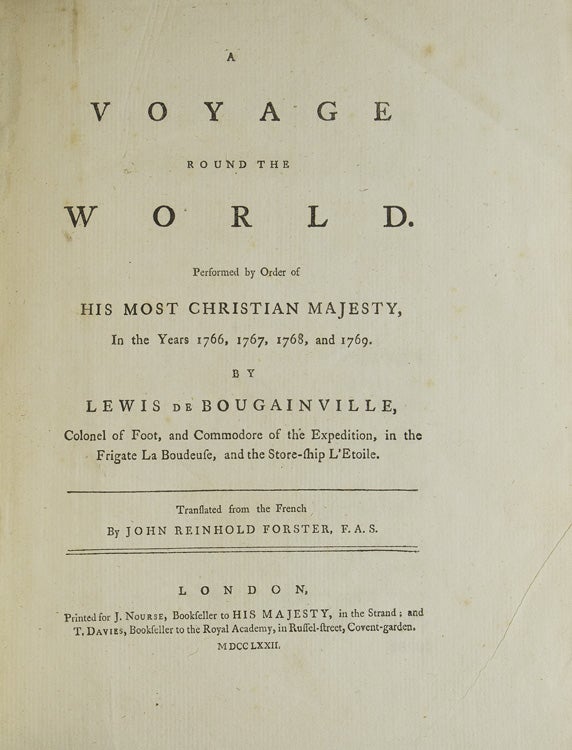The First French Circumnavigation
A Voyage round the World…In the years 1776, 1767, 1768, and 1769…Translated from the French by John Reinhold Forster….
London: Printed for J. Nourse…and T. Davies…, 1772.
Price: $6,000.00
About the item
First English Edition. 12 engraved maps and charts on 5 folding plates (including the Straits of Magellan), one folding engraved plate with the 3 images of Polynesian pirogues and a canoe, with the Tahitian vocabulary. 1 vols. 4to (261 x 211 cm.). The First French Circumnavigation. Contemporary brown calf , neatly rebacked, with corners renewed.Clean copyWith bookplate of Frank Streeter. Hill, p. 32; Sabin 6869; Kroepelien 113; O’Reilly and Reitman 285.
Item #305731
First English edition of the first French circumnavigation (first published in Paris, 1771). Bougainville’s command was to first turn over the Falkland (Malvinas) Islands to the Spanish, allies of the French. He tells the story of the discovery and occupation of the Falklands, and devotes a chapter to their natural history. He was at Buenos Aires when the order came to expel the Jesuits of Paraguay, which he describes in detail. He then continued through the Straits of Magellan and across the Pacific to the East Indies and thence home in a three year voyage which was France’s first official circumnavigation of the word. Many Pacific Islands were visited (there is a lengthy description of Tahiti, including a 300 word vocabulary of words used on the island at the end of the book), and although Bougainville made few important discoveries, the effect of his voyage on the French was to stimulate their interest in the Pacific, and inspire the later voyages of Du Fresne and La Pérouse. Bougainville (after whom the tropical flower is named) later fought in the American Revolution and was made a count of the Empire by Napoleon.
It was translated by John Forster, the Naturalist aboard the Resolution on James Cook's second voyage, 1772-75. France's first official circumnavigation was commanded by Bougainville who saw the strategic advantage in commanding the route to the Pacific around Cape Horn, hence his attempted colonization of the Falkland Islands in 1763 and his new charts of the Straits of Magellan. As well as bringing back news of his discoveries in the Pacific, Bougainville also brought back a Tahitian, Mayoa. It was the decision to return this young man to his home that prompted the French Government to mount another exploratory voyage led by de Fresne in 1771. Hill states that Johann Reinhold's son Georg, also Naturalist aboard the Resolution, may have been the actual translator of this work while Johann contributed the preface, dedication and footnotes.




